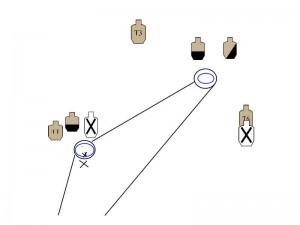The Mental Game USPSA, 3 – GUN
Sports Psychology
Mind Performance Enhancement
Once the basic skills are honed; Grip, Stance, Body Mechanics, the next step is to learn to use sports psychology tools to enhance performance. What can sports psychology do for your game?
-
Focus your effort
-
Boost motivation
-
Control under pressure
-
Increase consistency
-
Better time management
-
Improved flow
-
More FUN
It will not make the firearm run better. It does not replace physical and technical training either.
This article will go over some of the basic ideas and list links that can help to explain in more detail.
-
GOAL SETTING
-
Analyze what is going wrong
-
Have a baseline of your timed results
-
Use video to capture body mechanics, results of training and results of matches
-
Practice the shots that are 80% of the “C” – “D” and Missed/No shoots
-
Develop a training program to excel at your weak points
-
-
AROUSAL REGULATION – Body internals
1. make a list of best and worst stages shot and record from high to low
A. record Muscle Tension, Heart Rate, Breathing, and Anxiety
B. Look for trends in the results
2. Use Centering, Breathing and Relaxation tools
-
FOCUS
1. Develop CUE WORDS: Call your Shot etc.
2. Develop RE- Focus cues. Blink one eye, breath hard, reset grip etc.
-
IMAGERY VISUALIZATION
1. See Success
2. Manage energy level
3. Re-Focus
4. Rehearse responses
5. Smooth-ness, smooth is fast!
An example of a stage is provided below both layout and youtube video
to use for visualization training
-
SELF-CONCEPT
1. Self Confidence
A. Build Success into Training
B. Set measurable , challenging, yet achievable goals
C. Shoot with better competitors.
-
2. Self -Talk
A. Positive Thoughts
B. Practice Thought stopping
This information is from many sources which are listed.
USSA “Take your Brain to the Mountain” , Mental Skills in Alpine Ski Racing (c) 1999
A Guide Book for Athletes and Coaches in the Psychosocial Domain
ISSF – Competitive Shooting Psychology
Top-10-sports-psychology-articles-of-2014
MENTAL TRAINING: Creative Visualization Part I – An Overview
MENTAL TRAINING: Creative Visualization Part II – The Process
MENTAL TRAINING: Creative Visualization Part III – How it Works
IMAGE VIRTUALIZATION EXAMPLE
Use the picture and video to develop a mental image of every move you make.
This is a 12 round Comstock course
6 Paper Targets Starting left T-1 – Clockwise to T-6
2 No Shoots
Picture layout:
Break down the stage:
-How many targets ? How Many No Shoots ?
– Comstock no penalty other than time for extra shots
– Hands flat on Blue Barrel
– Right from the start you have to take the targets to the left, if you move past blue barrel it will be a BREAK IN 180 and a DQ!!
-You cannot shoot all targets from one spot, the 2nd set of Barrels blocks a target.
– look for a spot where you can take the last 4 targets just by shifting the upper body position
“bet there is one”.
-I will have to reload (I only have 11 rds to start)
-Reload while moving
Make a tactical plan: (this is my plan, mileage shall vary)
– Hand flat on barrel
– At sound draw
– move upper body left take both T1,2
– Reload while on the move ,
– move the whole body right till the sweet spot ie. take all four targets T3-6.
– Take T3/4 when shifting upper body left, T5/6 while shifting upper body right
– no need to run up
CLOSE YOUR EYES , Relax, run it through your mind in slow motion.
DO it over and over and every day.
Throw in a bobbled reload, a jam and slide clear, a jam drop magazine and slide clear
Throw in any type of screw up and recover using imagery.
In a typical match, about 5 minutes is allowed to look at the stage and move through it.
This is a simple stage. Consider a 24 rd count or 32 rd count course.
Author Notes:
80% of the game is mental. Learn to use sports psychology to your advantage.


